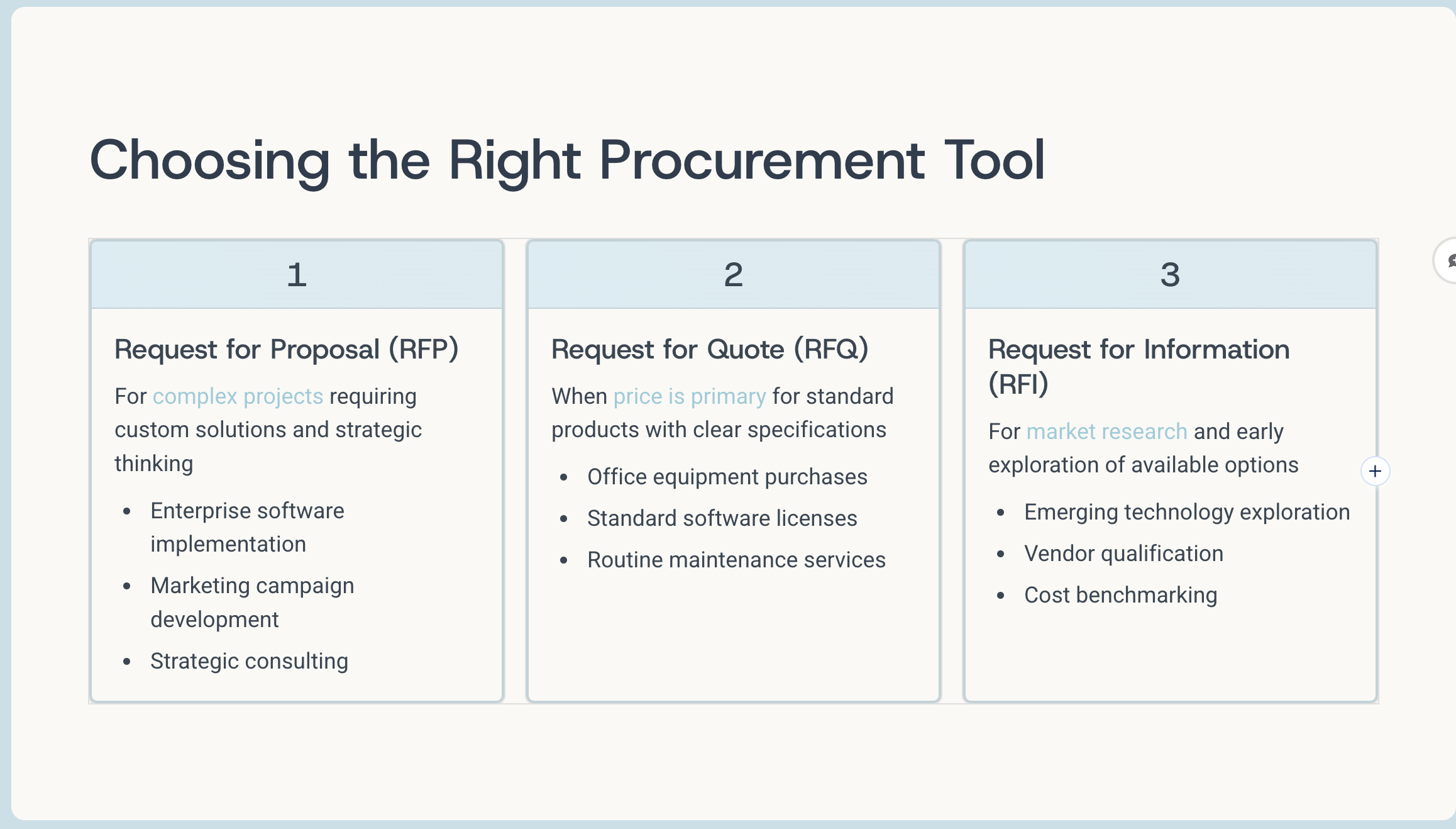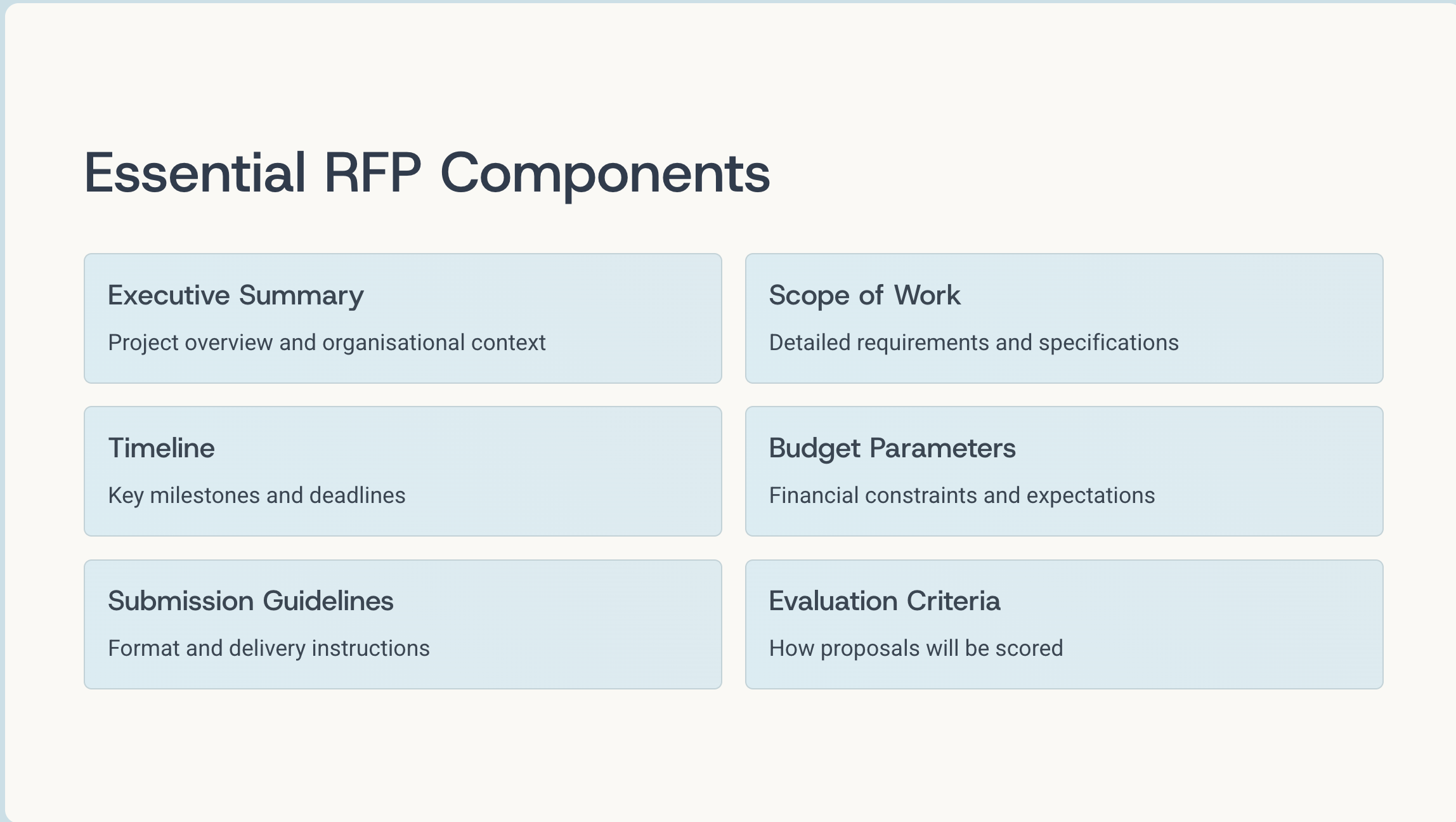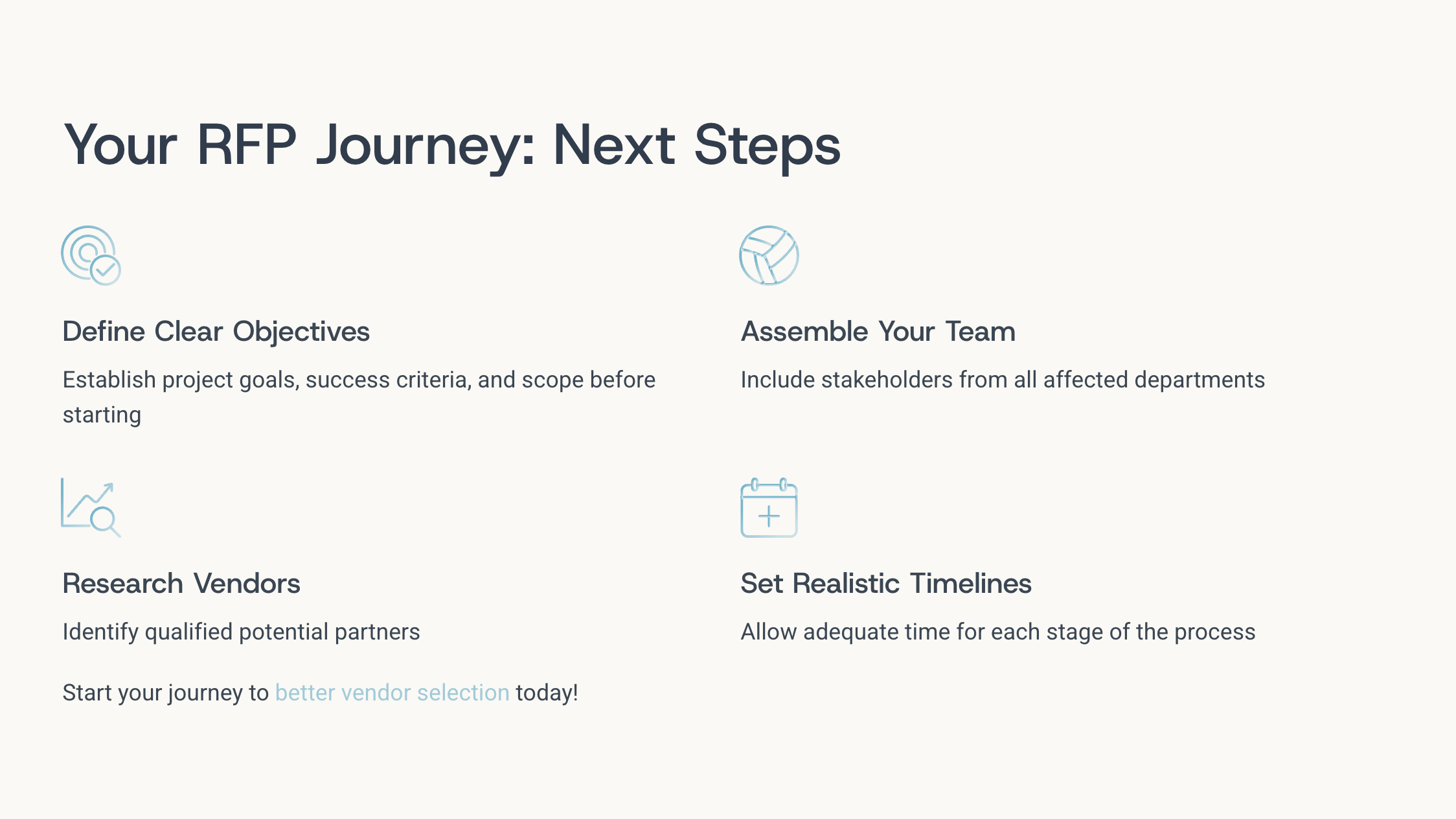What is an RFP? The Complete Guide to Request for Proposals
Article written by
Jaby K J

INSIDE THE ARTICLE
SHARE THIS ARTICLE
Summary
In this guide, you'll discover what an RFP is, how the entire process works from start to finish, the different types of RFPs you'll encounter, and even explore career opportunities in this growing field. By the end, you'll have the knowledge to either create effective RFPs for your organization or position yourself as a valuable RFP professional.
Every project starts with a question: who’s the right partner to get this done?
That’s where a Request for Proposal (RFP) comes in. An RFP is the tool organizations use to spell out what they need, invite vendors to pitch their solutions, and choose the best fit.
In this detailed guide, let's see what an RFP is, how the process works, what the different types you’ll see are, and even career paths in the RFP field. Whether you’re creating one, responding to one, or just curious, you’ll get everything you need to understand in the world of RFPs.
What is an RFP? (Core Definition)
In simple terms, a Request for Proposal (RFP) is a formal business document that organizations use to solicit bids from potential vendors, contractors, or service providers for a specific project or ongoing service. Think of it as a detailed job posting for businesses rather than individuals.
An RFP serves as both an invitation and a blueprint. It invites qualified vendors to submit their best proposals while providing them with all the necessary information to understand exactly what's needed, when it's needed, and how their proposals will be evaluated.
Key components that make up every effective RFP include:
- Project overview and objectives
- Detailed scope of work and requirements
- Timeline and key milestones
- Budget parameters or constraints
- Submission guidelines and deadlines
- Evaluation criteria and selection process
Unlike simple purchase orders or quote requests, RFPs are used for complex projects where multiple factors beyond price matter—such as expertise, approach, timeline, and cultural fit. This makes them different from everyday business transactions where you might simply call three contractors and choose the lowest bid.
How Does an RFP Work? (The Process)
Understanding how an RFP works requires looking at the complete process from both the buyer's and vendor's perspectives. Here's the step-by-step breakdown:
Step 1: Problem Identification and Planning
The organization identifies a need that requires external expertise or resources. This could be anything from developing a new website to implementing an enterprise software system. During this phase, internal stakeholders define the project scope, budget, and success criteria.
Step 2: RFP Creation and Documentation
The organization creates a comprehensive RFP document that clearly outlines their needs, expectations, and requirements. This document becomes the foundation for all vendor proposals and ensures everyone is bidding on the same scope of work.
Step 3: Vendor Outreach and Distribution
The RFP is distributed to qualified potential vendors through various channels—direct outreach, industry networks, government portals, or public postings. The goal is to reach vendors with the right expertise and capacity.
Step 4: Proposal Submission Period
Vendors analyze the RFP, ask clarifying questions, and prepare detailed proposals that address every requirement. This period typically ranges from two weeks to several months, depending on project complexity.
Step 5: Evaluation and Selection
The organization reviews all submitted proposals using predetermined criteria, often involving multiple stakeholders and scoring systems. This may include presentations, reference checks, and negotiation rounds.
Step 6: Contract Negotiation and Award
Once a preferred vendor is selected, both parties negotiate final terms, pricing, and contract details before signing a formal agreement to begin the project.

Types of RFPs and When to Use Them
Not all RFPs are created equal. Different sectors and situations call for different approaches:
Government RFPs (Public Sector Requirements)
Government RFPs are typically the most formal and regulated, with strict compliance requirements, transparency rules, and often complex scoring systems. These RFPs must follow specific procurement laws and are usually posted publicly to ensure fair competition.
Corporate RFPs (Private Sector Needs)
Private companies have more flexibility in their RFP processes, allowing for customized approaches based on company culture and specific needs. These often move faster than government RFPs and may include more subjective evaluation criteria.
Non-profit RFPs (Foundation and NGO Projects)
Non-profit organizations often issue RFPs for services like program evaluation, fundraising support, or community outreach initiatives. These typically emphasize mission alignment and social impact alongside technical capabilities.
Industry-Specific Examples:
- IT RFPs: Software development, system implementations, cybersecurity services
- Construction RFPs: Building projects, infrastructure development, facility management
- Marketing RFPs: Advertising campaigns, branding projects, digital marketing services
- Consulting RFPs: Strategic planning, organizational development, process improvement
What makes a RFP Document?
A well-structured RFP document serves as the roadmap for both the issuing organization and responding vendors. Here are the essential components:
Executive Summary and Project Overview
This section provides the big picture—why the project exists, what success looks like, and how it fits into the organization's broader goals. It should be compelling enough to attract top vendors while being realistic about expectations.
Scope of Work and Requirements
The most critical section that details exactly what needs to be done. This includes functional requirements, technical specifications, performance standards, and any constraints or limitations vendors should know about.
Timeline and Milestones
Clear deadlines for proposal submission, project start dates, key deliverables, and final completion dates. This helps vendors understand if they can realistically meet the organization's timeline.
Budget Parameters
While not always included, budget ranges or constraints help vendors propose appropriate solutions and avoid wasting time on proposals that are far outside the acceptable range.
Submission Guidelines
Detailed instructions on how to format and submit proposals, including required sections, page limits, file formats, and submission methods. Clear guidelines lead to more consistent, comparable proposals.
Evaluation Criteria
The specific factors and weightings that will be used to evaluate proposals, such as technical approach (40%), cost (30%), experience (20%), and timeline (10%). This transparency helps vendors focus their proposals effectively.
RFP vs. RFQ vs. RFI: Complete Comparison
Many people confuse these three similar-sounding procurement methods. Here's how to distinguish between them:
Feature/Aspect | RFP (Request for Proposal) | RFQ (Request for Quote) | RFI (Request for Information) |
|---|---|---|---|
Purpose | Evaluate vendors for complex solutions; invites creative and strategic proposals | Obtain price quotes for clearly defined products or services; focus is on cost | Gather market intelligence, capabilities, or options before defining project scope |
When to Use | When multiple approaches or expertise needed, requirements are complex or custom | When scope/specifications are well-defined and price is main factor | When still exploring options and market offerings, pre-RFP phase |
Typical Content | Project overview, scope, timeline, evaluation criteria, submission guidelines, requirements | Detailed specifications of product/service, quantity, and delivery terms | High-level questions about capabilities, experience, or suggestions |
Evaluation Criteria | Multi-factor: price, technical approach, experience, fit, value-add | Primarily lowest price meeting requirements | No formal evaluation; used to inform next steps |
Response Type | Detailed written proposal: solution, approach, team, pricing | Simple price quote or bid sheet | Informational response; may include brochures or general answers |
Outcome | Selection of best-fit vendor for project (may involve negotiation) | Purchase order or direct procurement | Decision about possible next step (may proceed to RFP/RFQ) |
Examples | Software implementation, marketing campaign, consulting engagement | Office supplies, standard equipment, commodity services | New technology exploration, supplier discovery, capability assessment |
Decision Matrix: Which One Should You Use?
When to use RFP (Request for Proposal): RFP is the correct choice for complex custom solutions. RFP works best when you need comprehensive vendor proposals with multiple solution approaches. RFP is ideal for projects requiring creativity, strategic thinking, or custom implementations.
- Enterprise software implementations requiring system integration
- Marketing campaigns needing creative strategy development
- Organizational restructuring projects requiring change management
- Custom manufacturing solutions with unique specifications
- Long-term service agreements requiring cultural fit assessment
- Strategic consulting engagements needing industry expertise
When to use RFQ (Request for Quote): RFQ is appropriate for standard products and services where price is the primary decision factor. RFQ works best when specifications are clearly defined and vendor capabilities are well understood.
Examples of when to use RFQ:
- Office equipment purchases with exact model specifications
- Routine maintenance services with established scope
- Standard software licenses with known requirements
- Commodity purchases where product differentiation is minimal
- Replacement parts with specific part numbers
- Standard training services with predetermined curriculum
When to use RFI (Request for Information): RFI is used for market research and early exploration phases. RFI helps organizations gather market intelligence before making specific procurement decisions. RFI is perfect when you need to understand available options and vendor capabilities.
Examples of when to use RFI:
- Emerging technology exploration before defining requirements
- New market entry research to understand supplier landscapes
- Capability assessment before major procurement initiatives
- Industry trend analysis to inform strategic planning
- Vendor qualification for future procurement opportunities
- Cost benchmarking across different solution approaches
Sequential procurement approach: Many organizations use RFI first for market understanding, then RFP for detailed solution proposals, then RFQ for specific component pricing. This sequence maximizes each tool's benefits while minimizing procurement complexity.
Decision factors summary:
- Complex requirements with multiple solution approaches = RFP
- Standard specifications with price focus = RFQ
- Market research and vendor discovery = RFI
- Strategic partnerships with multiple evaluation criteria = RFP
- Emergency purchases with time constraints = RFQ
- Innovation and creative solutions needed = RFP
Many organizations use these in sequence: RFI first to understand market capabilities, RFP second for detailed proposals, and RFQ last for specific pricing.
This sequential approach reflects how procurement complexity naturally evolves from exploration to execution. Once you understand which procurement method fits your situation, the next critical step is ensuring your chosen approach results in a legally binding agreement that protects both parties and enables successful project delivery.

What is a RFP Contract?
An RFP contract is the legally binding agreement that results from vendor selection. It incorporates the original RFP document, the winning vendor's proposal, and additional contract terms covering payment, intellectual property, liability, and dispute resolution.
The RFP becomes part of the contract foundation, establishing baseline requirements, while the proposal defines how the vendor will meet those needs. Additional contract terms address legal and commercial considerations like payment schedules, performance standards, and risk allocation.
How RFPs Lead to Binding Agreements
The RFP document becomes part of the contract foundation, along with the winning proposal and any negotiated modifications. This creates a comprehensive agreement that references the original requirements and proposed solutions.
Contract Terms Typically Included
Standard RFP contracts include scope of work, deliverables, timeline, payment terms, performance standards, intellectual property rights, confidentiality provisions, and termination clauses. The contract essentially codifies everything that was discussed during the RFP process.
Legal Considerations and Protections
Both parties gain protection through clearly defined expectations, remedies for non-performance, and dispute resolution procedures. The formal contract process also ensures compliance with procurement regulations and organizational policies.
Real-World RFP Examples
Let's examine three different RFP scenarios to illustrate how the process works in practice:
Example 1: Software Development Project
A mid-size retailer needs an e-commerce platform upgrade. Their RFP includes current system limitations, desired functionality, integration requirements, timeline constraints, and budget range. Vendors respond with technical architectures, development methodologies, team qualifications, and project timelines.
Example 2: Marketing Agency Selection
A B2B technology company wants to rebrand and launch a new product. Their RFP outlines brand challenges, target audiences, campaign objectives, and success metrics. Agency responses include creative strategies, campaign concepts, team credentials, and performance guarantees.
Example 3: Construction Project
A school district needs a new elementary school building. The RFP specifies educational requirements, building codes, sustainability goals, and community considerations. Construction firms propose designs, materials, construction approaches, and project management methodologies.
Each example demonstrates how RFPs adapt to different industries while maintaining the same core structure and evaluation principles.
What Is RFP Automation?
RFP automation refers to the use of digital tools and AI-driven platforms to simplify and accelerate the Request for Proposal (RFP) process for both issuers and responders. Traditionally a slow, manual, and paper-heavy workflow, the RFP lifecycle can now be streamlined through smart software that reduces friction at every stage—from drafting and distribution to evaluation and selection.
Definition and Benefits of RFP Automation Tools
RFP automation tools are software platforms built to digitize the full lifecycle of RFP management. These tools are used by procurement teams, sales organizations, and vendor management offices to:
- Create standardized, professional RFP templates
- Automate distribution and deadline tracking
- Enable collaborative evaluation and scoring
- Centralize vendor communication
- Track RFP progress in real time
Key benefits include:
- Less Admin Work: Automated workflows eliminate repetitive tasks like formatting, version control, and manual scoring.
- Faster Turnaround: Templates, auto-responses, and document libraries cut time-to-completion dramatically.
- Better Accuracy: Pre-approved content and data reduce the risk of errors and inconsistencies.
- Improved Compliance: Clear documentation trails and version control help meet legal and regulatory standards.

RFP Automation and AI: The 2025 Revolution
As we move deeper into 2025, RFP processes are experiencing dramatic transformation through emerging technologies that promise to revolutionize procurement and vendor selection.
AI-Driven RFP Creation
Advanced systems analyze historically successful RFPs, industry best practices, and organizational requirements to generate comprehensive RFP documents in days rather than weeks. Machine learning algorithms analyze thousands of past responses to identify patterns that predict vendor success, providing probability scores before contracts are signed.
Intelligent Proposal Analysis
Automated tools scan vendor responses for compliance, identify risks, extract key information for comparison, and detect inconsistencies that human reviewers might miss. Natural language processing enables sophisticated semantic analysis, helping evaluators understand how vendor approaches align with organizational objectives.
Predictive Analytics
Dynamic scoring algorithms incorporate real-time market data, vendor performance trends, and risk factors that traditional methods couldn't consider. Predictive cost modeling provides more accurate project investment projections by considering scope creep probability and market volatility.
Blockchain Integration
Vendor qualification verification using blockchain creates tamper-proof records of certifications and performance history. Smart contracts automatically execute agreement terms based on predefined conditions, reducing administrative overhead while providing stronger enforcement.
Organizations leveraging these technologies report 40-60% reductions in RFP creation time, 25-30% more vendor responses, and 15-20% cost savings from better vendor competition.
How Technology Is Streamlining the RFP Process
Modern platforms go beyond simple digitization. They're built to think, learn, and adapt.
Core Technological Features
- Smart Templates: Pre-built RFP structures that auto-populate standard questions and requirements.
- AI-Powered Response Engines: Generate first drafts using past responses and contextual content.
- Collaboration Workspaces: Let multiple stakeholders draft, comment, and review in real time.
- Automated Scoring Matrices: Apply scoring logic to vendor responses for objective evaluations.
- Vendor Management Modules: Store vendor profiles, past performance data, and contact history.
- Analytics Dashboards: Visualize timelines, progress, bottlenecks, and win/loss trends.
What used to take weeks now takes days—or even hours—with the right setup.
How SparrowGenie Is Redefining RFP Automation
SparrowGenie isn’t just another RFP tool. It’s the AI-secured sidekick that helps sales, presales, and proposal teams move faster, stay accurate, and win more deals—without the usual burnout.
Here’s how:
- Auto-Generated First Drafts (in Minutes)
Genie's AI assistant creates accurate first drafts for RFPs, RFIs, DDQs, and proposals—using your approved content and brand voice. - Centralized Knowledge Library
No more digging through folders or past docs. All your approved answers, policies, and decks are structured into an always-on, searchable hub. - Real-Time AI Chat Assistant
Ask anything—“Do we support SOC 2?” “What’s our refund policy?” —and Genie gives you verified answers instantly, with citations. - Live Proposal Insights
Track who viewed your proposal, what they clicked on, and how long they spent—so you can follow up at the right time, with the right context. - Seamless Cross-Team Collaboration
Built for sales, legal, finance, and compliance to review and approve content without ping-ponging over email. - Enterprise-Grade Security
SOC 2 certified, GDPR-compliant, and built with audit trails. So you can automate responses and meet enterprise compliance. - Slack & Teams Native Integration
Draft proposals, fetch content, or get AI help—right where your team already works.
Want to create an RFP in a couple of minutes? Check out our free RFP Generator!
The Real Pros and Cons of Using RFPs
Let’s not sugarcoat it—RFPs are powerful but imperfect.
The Good | The Hard |
|---|---|
Competitive Pricing & Innovation Because vendors are pitching side-by-side, you get stronger offers and fresh ideas. | Time-Intensive From drafting to evaluation, RFPs require serious effort across departments. |
Structured Vendor Comparison It’s easier to compare apples to apples when responses follow a consistent format. | Heavy Admin Load Managing versions, scoring, and communication takes planning—and often, dedicated tools. |
Legal & Regulatory Compliance Documented, transparent processes protect your organization—especially in government or regulated industries. | Vendor Burnout Risk If the process feels unfair, overly complex, or predetermined, vendors will hesitate to participate again. |
4 RFP Mistakes You Don’t Want to Make
Avoid these, and you’ll already be ahead of most:
- Vague Requirements
If vendors don’t know what you want, their proposals will be vague too. Be specific. - Unrealistic Timelines or Budgets
Ambitious is fine. Impossible is not. Give vendors a real shot at success. - Weak Evaluation Criteria
If your scoring doesn’t reflect actual priorities, you’ll end up picking the wrong vendor for the wrong reasons. - Poor Vendor Communication
Late responses or inconsistent info erodes trust and leads to confusion. Treat vendors like partners, not obstacles.
What Happens After You Receive RFP Responses?
Once the proposals are in, the real decision-making begins. The evaluation team—often made up of cross-functional stakeholders—reviews each response against predetermined criteria. But it doesn't stop there.
The shortlisted vendors are typically invited to present their solutions. Some might be asked to run proof-of-concept demos. Reference checks are done quietly in the background. Security and compliance teams might step in. And negotiations usually begin with the top 1–2 contenders.
At this stage, it’s not just about who filled out the form correctly—it’s about who can actually deliver.
What Happens to the Proposals That Don’t Win?
Frankly, even the losing bids aren’t worthless.
Smart procurement teams don’t just archive them and move on. Instead, they study these responses to track pricing benchmarks, spot emerging industry trends, or see how competitors are positioning themselves.
In some cases, organizations even maintain a searchable internal database of past RFP responses—turning them into strategic assets, not just digital clutter.
Why You Should Build an RFP Response Database
Think of every RFP response you receive as a window into the market.
Over time, these responses reveal:
- What vendors are charging—and how that’s changing
- Which features are becoming standard (or disappearing)
- How providers describe value in your industry
- Who keeps showing up in your top 3—and why
With a well-maintained RFP response database, you're not just picking vendors—you're building institutional knowledge that sharpens every future procurement decision.
ROI of RFP Automation
RFP automation delivers a strong, data-backed return on investment (ROI) by reducing manual effort, boosting win rates, and enabling teams to scale proposal volume without scaling headcount. Here’s a detailed breakdown of the ROI of RFP automation, using industry benchmarks and real-world business scenarios:
Time and Cost Savings
- Efficiency Gains: Automation software can reduce RFP turnaround times by 40–60%.
- Labor Reallocation: For a 10-person sales team, RFP work often represents 20–30% of the annual workload—thousands of hours that can be cut by half.
- Quantified Example: A team spending 5,800 hours yearly on RFPs (at $50/hour) incurs $290,000 in costs. Automation can reclaim $145,000–$175,000 per year for a mid-sized team.
Increased Proposal Throughput and Revenue
- Cycle Acceleration: Organizations can respond to 25–43% more RFPs per year, increasing opportunities without adding headcount.
- Win Rate Uplift: Leading teams using AI-powered RFP platforms report a 16% increase in win rates, directly translating to higher revenue per RFP effort.
- Revenue Impact: If the average RFP deal size is $100,000 and a team responds to 20 more RFPs per year due to automation, that’s up to $2 million in new pipeline—before even including win-rate improvements.
Quality, Accuracy, and Compliance Gains
- Error Reduction: Automation decreases error rates by up to 30% and ensures responses are consistent and compliance-ready, minimizing risk of costly mistakes or lost deals.
- Brand Consistency: Centralized content and templating preserve brand and legal messaging, reducing approval loops across legal/compliance.
Strategic Resource Utilization
- Better Use of Talent: Highly skilled team members spend more time tailoring strategy and less on repetitive admin, increasing employee satisfaction and retention.
- Reinvestment: Time saved can be invested in pursuing more strategic/high-value opportunities, entering new markets, or personalizing proposals.
Measurable ROI Calculation
Sample ROI Formula:
If automation saves $145,000/year, increases revenue by $32,000, and costs $50,000/year to license:
ROI=(145,000+32,000)−50,000/50,000=254%
Soft ROI & Intangibles
- Faster, Smarter Feedback Loops: Built-in analytics reveal bottlenecks and high-performing content.
- Happier Teams: Automation reduces burnout, lowers turnover, and makes work more rewarding.
- Scalability: Teams can handle growth without adding headcount or burning out existing staff.
RFP automation transforms the cost and capacity dynamics of proposal management. It isn’t just a “nice-to-have”—it’s a proven, high-ROI lever that lets organizations close more deals, waste less effort, and drive compliance at scale.
Want to Work in the RFP World? You’re in Luck.
RFPs might sound bureaucratic from the outside, but managing them is increasingly becoming a strategic, full-time role—especially in enterprise sales and procurement.
From RFP writers to proposal managers and sourcing leads, the field is growing fast.
What Does a RFP Writer Actually Do?
An RFP writer isn’t just a copywriter. They’re a project manager, a communicator, and a translator—bridging the gap between internal needs and external solutions.
They:
- Draft and manage the entire RFP document
- Coordinate input from multiple departments
- Handle vendor queries and clarifications
- Ensure the final RFP is compliant, comprehensive, and clear
It's a high-trust role that directly impacts what vendors deliver—and what your organization pays.
Skills That Make a Great RFP Writer
If you're eyeing this field, here’s what you need:
- Clear, persuasive writing
- Strong organization and time management
- A nose for detail and compliance
- The ability to collaborate across departments
- Bonus: experience with technical writing or procurement tools
Where Do RFP Writers Work?
You’ll find them across industries—in tech companies, government agencies, logistics firms, and consulting agencies, and as freelancers or contractors.
Whether you’re helping issue RFPs or respond to them, there's a growing demand for this hybrid skill set.
How to Break Into the Field
There’s no single path, but most RFP professionals come from one of these backgrounds:
- Business analysis or project coordination
- Sales enablement or bid management
- Technical writing or content strategy
Certifications like APMP (for proposal management), PMP (for project management), or supply chain credentials can help you stand out. So can volunteering for RFP-related projects inside your current organization.
Career Growth and Salary
Entry-level RFP roles typically start around $45,000–$65,000 per year. With experience, this can grow to $100K+, especially if you move into roles like Senior Proposal Manager, Procurement Strategist, or Director of Strategic Sourcing.
Final Thoughts
At their best, RFPs are tools for clarity, fairness, and smart decision-making. They help buyers find the right partners—and vendors prove their value on merit.
But to get there, you need more than a template.
You need thoughtful planning, clear goals, and the right systems in place. Whether that’s a centralized intake process, cross-team collaboration, or a platform like SparrowGenie to automate the grunt work—how you manage the RFP process defines what you get out of it.
Done well, RFPs lead to better vendors, stronger outcomes, and reduced risk.
Done poorly, they waste time, frustrate everyone, and damage trust.
The choice is yours.
Ready to see how AI can transform your RFP process?
Product Marketer at SparrowGenie
Once chasing a half-cooked Ph.D. dream in Literature amidst the stacks of academia, Jaby has successfully pivoted to become a product marketer in the SaaS industry, leveraging her background in writing, research, and storytelling to create meaningful brand narratives.
Frequently Asked Questions (FAQs)
Related Articles

RFP Automation Platforms: Features, Benefits, and Real ROI

Why AI Proposal Writing Needs the Human Touch
